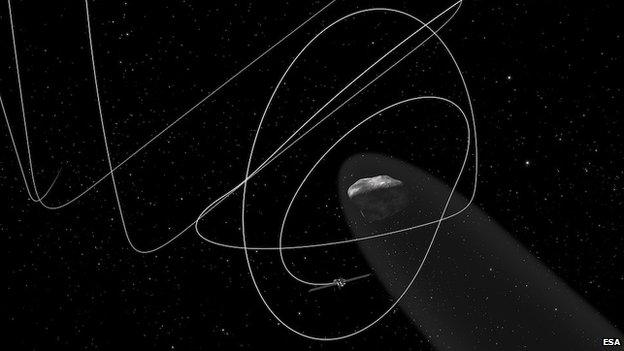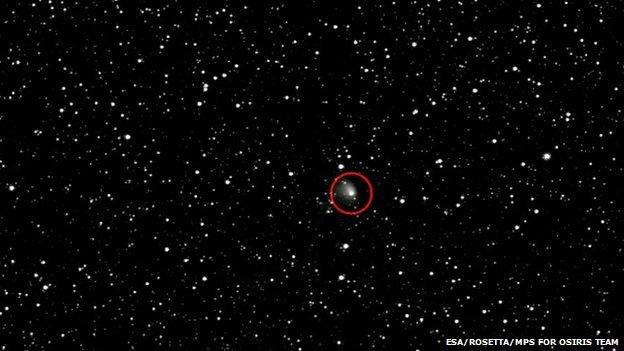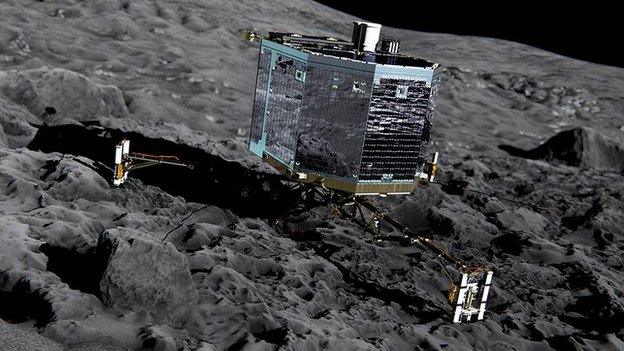Rosetta comet-chaser completes 'big burn'
- Published

Rosetta will fly around the comet, edging ever closer before dropping off its landing probe
Europe's comet-chaser Rosetta has taken a big step towards making its historic rendezvous with a 4km-wide ball of ice and rock in early August.
Controllers confirm the spacecraft conducted a major orbit manoeuvre on Wednesday without incident.
The near-eight-hour thruster burn was designed to slow the satellite's speed relative to Comet 67P/C-G.
More adjustments are required, but the operation was a significant event in ensuring Rosetta, external meets its target.
The pair are roughly 500 million km from Earth and separated by about a million km, and closing.

Sylvain Lodiot watches the telemetry come down from Rosetta, 500 million km from Earth
Wednesday's big burn was initiated at 15:23 GMT (16:23 BST; 17:23 CEST). It was intended to take out a big chunk (almost 300m/s) of the velocity Rosetta had (755m/s) with respect to 67P/Churyumov-Gerasimenko.
Engineers at the European Space Agency's (Esa) "mission control" in Darmstadt, Germany, will have to examine in detail the telemetry they received from the satellite but confirmed on Thursday that the manoeuvre was "completed nominally".
"The thrusters and propulsion system overall performed very well, and we had a nominal completion of the burn at 22:39 UTC (00:39 CEST Thursday)," said Rosetta Spacecraft Operations Manager Sylvain Lodiot.
"It will take a few days for the flight dynamics team to analyse data and determine the final actual change in speed, but it won't be too far from what we planned," he told the mission blog, external.
There had been some concern prior to the burn that a leak in the system used to pressurise the propellant tanks might result in uneven combustion, but Paolo Ferri, who heads up the European Spacecraft Operations Centre (Esoc), described Rosetta as having "very stable performance".
Comet 67P/C-G is travelling around the Sun on a big loop that takes it out beyond the orbit of Jupiter and then back in to just inside the orbit of Mars.
Rosetta is attempting to target its rendezvous at the start of the inward curve, before our star can warm the icy object to trigger large jets of gas and dust from its surface.
The mission goal is to orbit the comet, starting on 6 August, and then follow the body in its orbit.
In November, an attempt will be made to put a small lander, called Philae, on 67P's surface.
If all goes well, the mission should return some remarkable insights on the behaviour and chemical make-up of its icy quarry.
Eight further burns are required to get Rosetta into position. The next two, on 4 June and 18 June, are somewhat smaller than Wednesday's manoeuvre.


67P/Churyumov–Gerasimenko already shows signs of a developing halo, or coma, around its nucleus
Jonathan.Amos-INTERNET@bbc.co.uk and follow me on Twitter: @BBCAmos, external
- Published7 May 2014

- Published28 March 2014

- Published21 March 2014

- Published20 January 2014

- Published10 December 2013

- Published18 September 2013
- Published29 March 2012